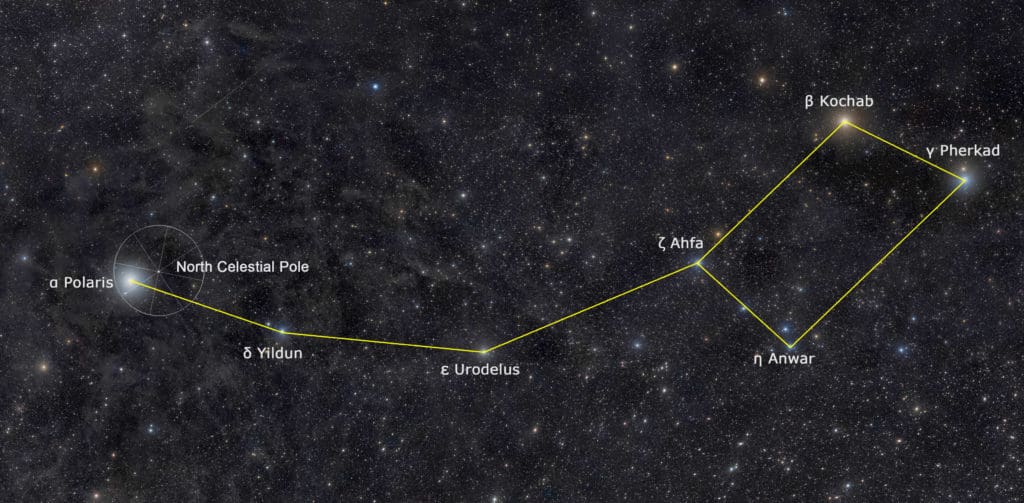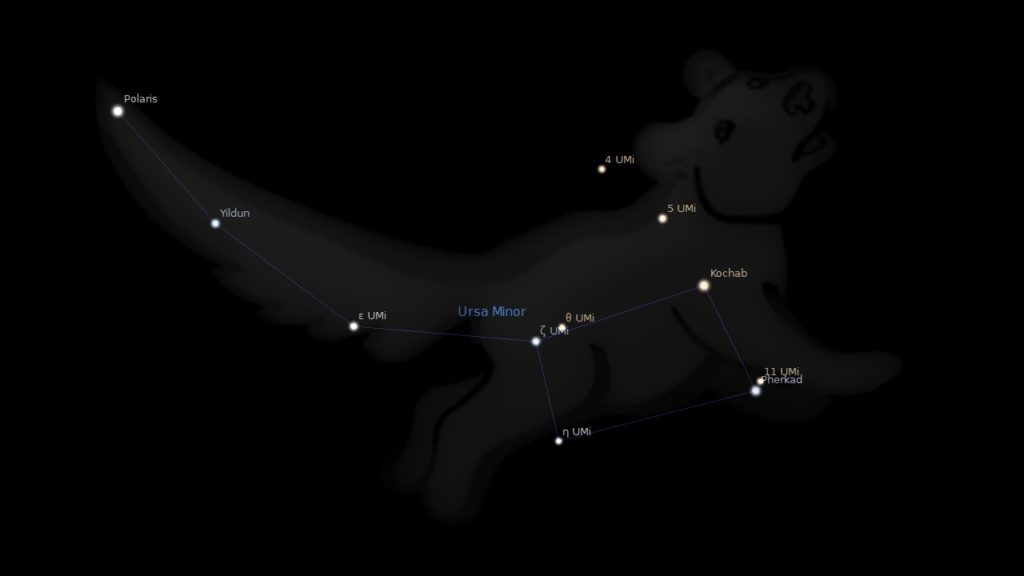Kochab, designated as Beta Ursae Minoris, is the second-brightest star in the constellation of Ursa Minor, the celestial “little bear”. It is one of the stars that form the Little Dipper asterism.
Key Facts & Summary
- Kochab is located at around 130.9 light-years away from our Solar System.
- It is the brightest star in the bowl of the Little Dipper, and the second-brightest star in the constellation of Ursa Minor, after Polaris, which is the North Star.
- Kochab has an apparent magnitude of 2.08, and an absolute magnitude of -0.83, being slightly fainter than Polaris, the North Star, which has an apparent magnitude of 1.98.
- Since Polaris is a variable star, displaying brightness variations from magnitude 1.86 to 2.13, Kochab sometimes takes its place as the brightest star in Ursa Minor, the celestial little bear.
- Kochab is part of the famous asterism, the Little Dipper, which is the smaller version of the more prominent Big Dipper asterism.
- The Little Dipper asterism is formed out seven stars, namely Kochab, Polaris, Yildun, Pherkad, Ahfa al Farkadain, Anwar al Farkadain, and Urodelus.
- Kochab is the second-brightest, and sometimes the brightest star in the Little Dipper asterism.
- Kochab is also a former North Pole Star. It was our North Star in the year 2500 BCE.
- Kochab is a giant star of spectral type K4 IIII. It is expanding in size, having 2.2 solar masses, and 42.06 solar radii, making it 84 times bigger than our Sun.
- Kochab is also 390 times brighter than our Sun, however, it is cooler than our Sun, with average surface temperatures reaching only 4,030 K.
- One exoplanet has been confirmed to orbit Kochab. It is designated as Beta Ursae Majoris b.
- The best time of the year to observe Kochab, the Little Dipper Asterism, and thus the stars and deep-sky objects in the Ursa Minor constellation, is during June when the constellation is the most prominent in the night sky.
β Ursae Minoris
Beta Ursae Minoris is traditionally known as Kochab, a name that appeared for this star in the Renaissance, and its meaning remains a bit vague to this day.

Some speculated that Kochab may come from the Arabic “al-kawkav”, or the Hebrew “kokhav”, both translate to “star”. Others believe that Kochab is derived from “Alrucaba” or “Rucaba”, a name which is applied to Theta Ursae Minoris.
Regardless of its origin, the name Kochab was officially approved for Beta Ursae Minoris by the WGSN in 2016.
Formation
Beta Ursae Minoris formed around millions of years ago from an interstellar medium of gas and dust. Gravity pulled the swirling gas and dust together and resulted in the part-time brightest star in the constellation of Ursa Minor, now known as Kochab.
Kochab’s exact age is still disputed, with most estimating that it is around 2.95 billion years old, give or take 1 billion years.
Distance, Size, and Mass
Kochab is located at around 130.9 light-years / 40.1 parsecs away from our Solar System. It is bright enough to be seen with the naked eye.

Kochab has around 2.2 solar masses, or 220% of our Sun’s mass, and 42.06 solar radii, or 4,206% of our Sun’s radius. Thus, Kochab is 84 times bigger than our Sun.
Other Characteristics
Kochab is an orange-hued giant star of spectral type K4 IIII. It is expanding in size as it is in this stage. It is 130 times more luminous than our Sun, while its enlarged atmosphere is radiating 390 times as much luminosity as the Sun.
Kochab has an apparent magnitude of 2.08, and an absolute magnitude of -0.93. It is the second-brightest star in Ursa Minor, however, since the brightest star, Polaris / Alpha Ursae Minoris, is a variable star, varying from magnitude 1.86 to 2.13, Kochab sometimes takes its place as the brightest star in Ursa Minor.

Beta Ursae Minoris is cooler than our Sun, having surface average temperatures of around 4,030 K. This star has a radial velocity of +16.96 km / 10.5 mi per second, while its rotational velocity is at 8 km / 4.9 mi per second. Its surface gravity has been recorded at 1.83 cgs.
Kochab, the Former North Pole Star
Kochab was one of the North Pole stars around the year 2500 BCE. The current pole star in our era is the slightly brighter Polaris star / Alpha Ursae Minoris.
Around the year 2467 BCE, the true north was best observed by drawing a plumb line between the stars Mizar and Kochab. The ancient Egyptians noticed this, as they aligned the Great Pyramid of Giza with it.

The cycle of the succession of the pole stars occurs due to the precession of the equinoxes. As precession continued, around the year 1100 BCE, Kochab was within 7o of the northern celestial pole.
After 200 BCE, Kochab and Pherkad were closer to the pole and they both served as twin pole stars, circling the North Pole, from around 1700 BCE until just after 300 AD. Today, both stars are sometimes referred to as the “Guardians of the Pole”, as they surround the current north star, Polaris.
Planetary System
Kochab has been confirmed to host an exoplanet, which is around 6.1 times as massive as Jupiter. It has an orbital period of around 522 days.
Location
Kochab / Beta Ursae Minoris is located in the constellation of Ursa Minor, the celestial “little bear”. It is the second-brightest star in this constellation, and periodically the brightest.
The constellation of Ursa Minor, just like its grander counterpart, Ursa Major, is marked by the famous asterism the Little Dipper, while Ursa Major is marked by the Big Dipper.

The Little Dipper is formed by seven stars, namely Kochab, Polaris, Yildun, Pherkad, Ahfa al Farkadain, Anwar al Farkadain, and Urodelus. Kochab is the brightest star in the bowl of the Little Dipper.
The constellation of Ursa Minor was created around the year 600 BC, form the stars that previously marked the wings of Draco, the celestial dragon, by the Greek astronomer and philosopher Thales of Miletus.
The constellation was later included in Ptolemy’s star catalog, Almagest, in the 2nd century, which consisted of 48 constellations. Ursa Minor is now among the 88 modern constellation, where it holds the place of the 56th largest constellation in the sky, stretching for around 256 square degrees.

Ursa Minor hosts many interesting stars such as Polaris, the current North Pole Star, Kochab, a former pole star, Pherkad, Yildun, Ahfa al Farkadain, Anwar al Farkadain, and Urodelus, among many others.
Ursa Minor hosts a couple of deep-sky objects as well, such as the Ursa Minor Dwarf galaxy, Polarissima Borealis, the closest galaxy to the North Celestial Pole, the barred spiral galaxy NGC 6217, or the supergiant elliptical radio galaxy NGC 6251, among others.

The best time of the year to observe Kochab, the Little Dipper asterism, and the other stars and deep-sky objects in the constellation of Ursa Minor, is during the month of June, when the constellation is the most prominent.

Did you know?
- The ancient Egyptian astronomers referred to Kochab and Mizar as “The Indestructibles”, lighting the North.
- Space enthusiasts can use Kochab as a precise guide for setting up a telescope, as the celestial north pole is located 43 arcminutes away from Polaris, very close to the line connecting Polaris with Kochab.
- The Chinese know Kochab as Bei Ji er – the Second Star of North Pole, representing the Emperor.
- In Chinese astronomy, Kochab is part of the Bei Ji – the North Pole asterism, along with Gamma Ursae Minoris, 5 Ursae Minoris, 4 Ursae Minoris, and Struve 1694.
- In Inuit astronomy, the three brightest stars of Ursa Minor – Polaris, Kochab, and Pherkad, were known as the Nuutuittut – the “never moving”, though the term is often used for Polaris alone, rather than the trio of stars.
Sources:
Image Sources:
- https://earthsky.org/upl/2015/06/kochab-lg-e1466020756548.jpg
- https://www.perseus.gr/Images/star-brightest-umi-beta.jpg
- https://imgproxy.geocaching.com/5f854d8aa5f3f551f74bc08fc2a33fc0de02098c?url=http%3A%2F%2Fdeepskycolors.com%2Fastro%2F2011%2F05%2Fmb_2011-05_LittleDipper_Labels.jpg
- https://live.staticflickr.com/3698/10183301404_287a499afd_b.jpg
- https://astrologyking.com/wp-content/uploads/ursa-minor-constellation.jpg
- https://www.daviddarling.info/images/Little_Dipper.jpg
- https://www.universeguide.com/pictures/constellations/stars/ursaminorlocationkochab.png
- https://nineplanets.org/wp-content/uploads/2020/07/NGC_6217_hs-2009-25-bc.jpg
